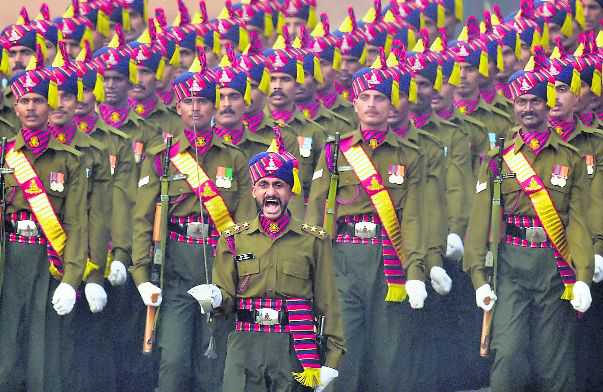India needs the best of warriors, weapons and war strategies. This necessitates a quantitative reduction and a qualitative upgradation of the services’ manpower. The historic initiative of right-sizing need to be sustained, supported and carried forward. That can, hopefully, facilitate India’s graduation towards a world class military power.


Bhartendu Kumar Singh
Indian Defence Accounts Service
Large manpower of our armed forces is increasingly becoming a concern. Uncertain impact on combat capabilities apart, sheer numbers are also leapfrogging towards huge revenue and pension expenditure. There is insufficient money for modernisation efforts. Therefore, the recent initiative by army to study ‘right sizing’ challenge is a commendable policy step since this could propel India’s tryst with Revolution in Military Affairs (RMA). However, unless the study is conducted in an open and transparent environment, the intended objectives would continue to elude.
The Indian Army has seen a four-fold increase in its manpower strength since 1947. None of the great powers like the US, Russia, China, the UK, or France have had this kind of increasing trajectory. In fact, all of them had a decreasing trend after the vortex of Cold War was over. For example, the US, which had over 3.37 million total armed forces personnel at the peak of Cold War in 1967, has 13.54 million personnel now. Similarly, China, which had a manpower strength of 4.9 million armed forces personnel during Cold War days, has now around two million personnel. Numerous studies have proved that the combat capability of the Chinese PLA has indeed been enhanced due to manpower rationalisation and trimming.
In the Indian context, sporadic manpower reduction efforts in the past ccould not succeed. Many strategic experts chaffed at the idea, partially out of what Samuel S Huntington may have called as ‘confused and unsystematic set of assumptions about civil-military relationship’. No serious and acceptable reform proposals were allowed to emerge on the discussion table. Even when civilian manpower underwent reductions at every level in the government and fresh recruits guided towards the new pension scheme (NPS), the military rank and file kept proliferating. The dominant theme being propagated was that of a massive shortage of manpower in the armed forces, particularly at the officer cadre level. Strategic experts had (and still have) their own narratives of manpower shortages and why urgent steps were needed to plug the same. Such assumptions of the ‘so-called shortages’ are based on archival notions of ‘authorised versus posted manpower strength’ and blissfully ignore the contemporary realities where the services’ engagements need to be functionally reviewed so as to do away with superfluous activities.
This dichotomy between global trends and the Indian approach is due to many factors.
1There is a civil-military compartmentalisation in national security consciousness. Despite attempts to forge a common approach to national security in institutions like the National Defence College (NDC) for senior civil and military officers, perceptional division remains in situ. The services, partly out of their training, working culture and professional military ethics, stand for a dominating security policy. Demands for more budget and more manpower have to be understood in this context.
2The armed forces practice conservative realism and support established values, institutional practices and functional expanse. There is an institutional reluctance to revise them and learn from best practices elsewhere. Some of these practices, like the orderly system and the involvement in basketful of non-core activities like running educational institutions, commercial complexes etc, lead to avoidable proliferation of rank and file.
3 There are few lateral mobility options for armed forces personnel in other professional fields. Media hype and hoopla notwithstanding, our soldiers have to demand respect and remain at the margins of social life. For example, despite the armed forces remaining stout champions of democratic values, very few military men have managed a political career. Such economic, social and political marginalisation deprive them an encompassing and comprehensive outlook of society to appreciate issues such as manpower reduction.
Contemporary experiences show that numerical preponderance and military modernisation do not go hand-in-hand. Manpower has been reduced in many countries to rationalise ‘teeth-to-tail’ ratio and spend the precious penny on weapons. Further, the nature of warfare is constantly changing where the physical hand-to-hand fight is being replaced by new platforms such as cyber warfare. Instead of dismantling enemy tanks, the challenge is to cripple the enemy’s functional system in critical fields. When we hypothesise a war scenario 20 years later, war techniques would have become more automated and indeed robotised. Infantry and mechanised infantry would be performing rear guard duties. Thus, the technological imperatives necessitate a technically educated manpower profile to handle the future warfare scenario. In the Indian context, unless the numbers are reduced, a qualitative pushover is difficult.
The present initiative seems to be a response to public policy calls for manpower reduction and jointness since 2015 and a look beyond the Shekatkar Committee’s recommendations on manpower reduction. One of the reasons why the Shekatkar Committee did not come up to expectations was its inability to conceptualise the issues and ask the right questions to itself. For example, the political economy of military modernisation warrants that revenue expenditure be capped to a maximum of 50 per cent of the defence budget. Such issues were ignored. Perhaps, that explains why it could not go beyond cosmetic recommendations, necessitating a comprehensive study afresh by the army.
India needs the best of warriors, weapons and war strategies. This necessitates a quantitative reduction and a qualitative upgradation of the services’ manpower. The historic initiative of right-sizing need to be sustained, supported and carried forward. That can, hopefully, facilitate India’s graduation towards a world class military power.
Views are personal
